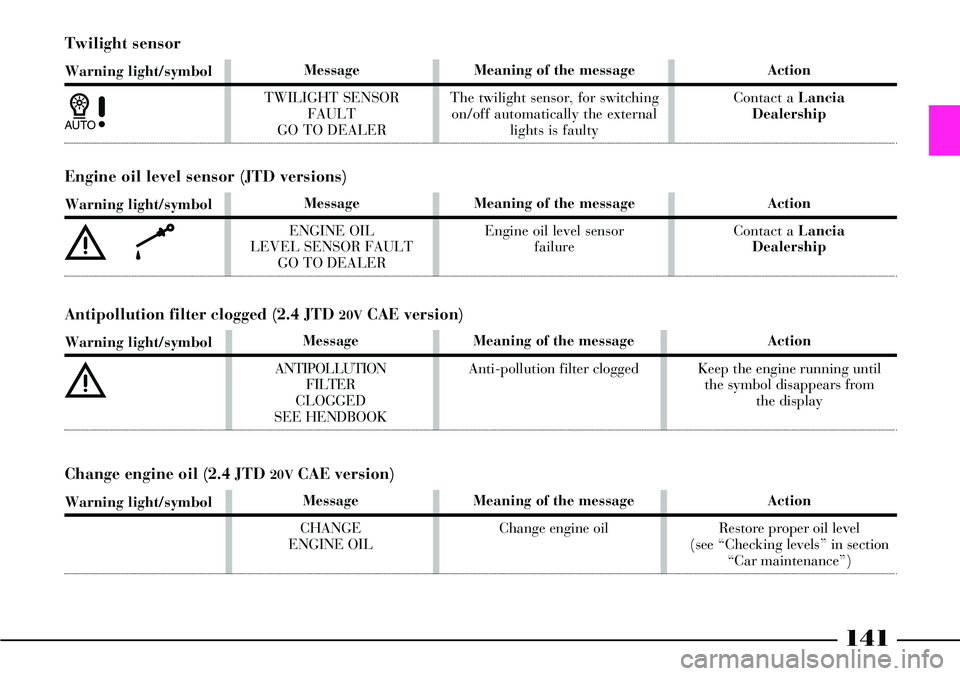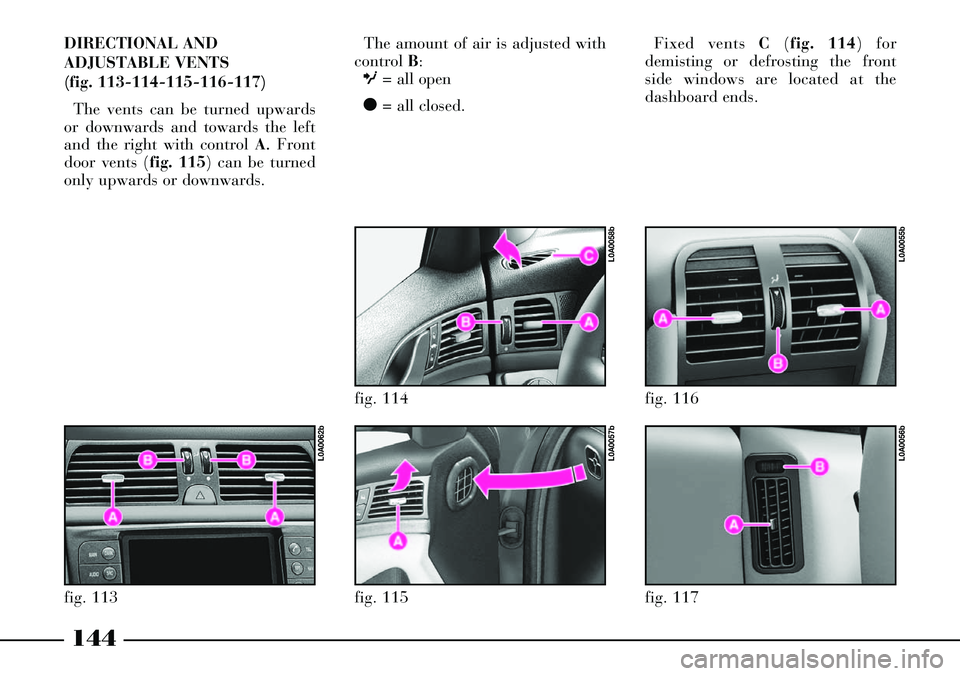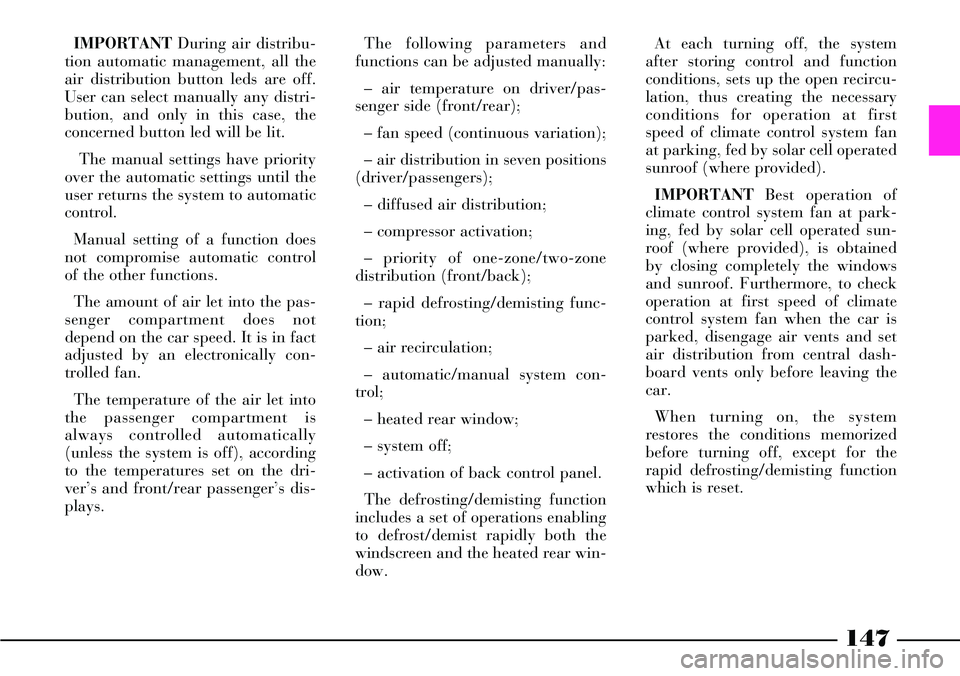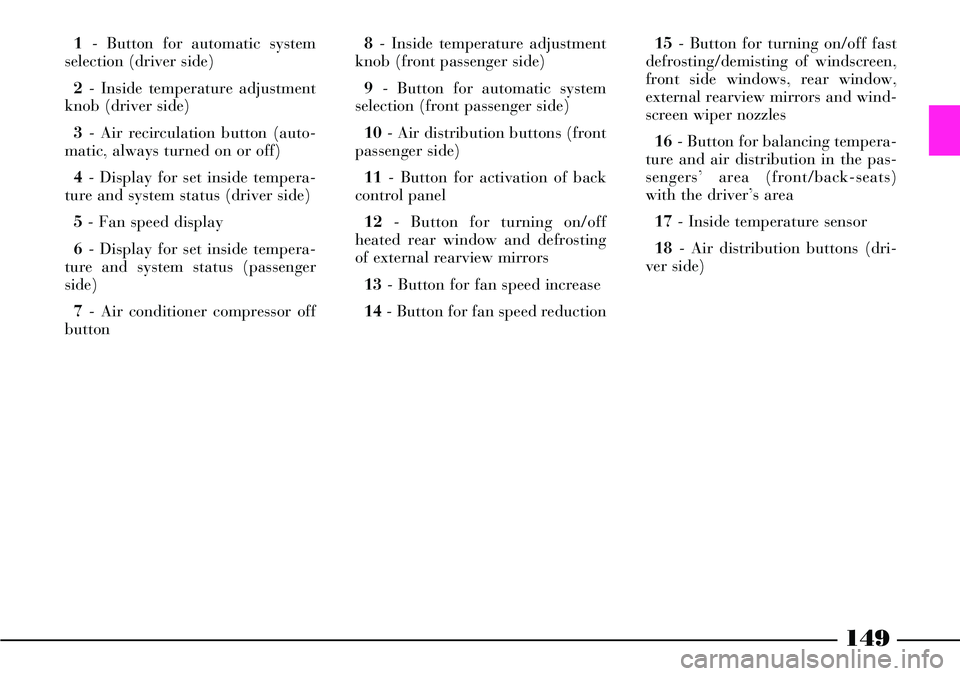Lancia Thesis 2007 Owner handbook (in English)
Manufacturer: LANCIA, Model Year: 2007, Model line: Thesis, Model: Lancia Thesis 2007Pages: 386, PDF Size: 8.69 MB
Page 141 of 386

Action
The presence of water
in the fuel circuit may
cause serious damage
to the entire injection system
and cause irregular engine
operation. If there is water in
the fuel filter or the sensor is
faulty contact a Lancia
Dealership as soon as possible
140
Parking sensors
Warning light/symbol
t
Message
PARKING SENSOR
FAULT
GO TO DEALERMeaning of the message
One or more parking sensor
failureAction
Contact a Lancia
Dealership
Diesel fuel filter (JTD versions)
Warning light/symbol
c
èc
Message
MOISTURE IN DIESEL
FUEL FILTER
GO TO DEALER
DIESEL FUEL FILTER
SENSOR FAULT
GO TO DEALERMeaning of the message
Water in diesel fuel
filter
Water in diesel fuel filter sensor
failure
Page 142 of 386

141
Twilight sensor
Warning light/symbol
1
Message
TWILIGHT SENSOR
FAULT
GO TO DEALERMeaning of the message
The twilight sensor, for switching
on/off automatically the external
lights is faultyAction
Contact a Lancia
Dealership
Engine oil level sensor (JTD versions)
Warning light/symbol
èk
Message
ENGINE OIL
LEVEL SENSOR FAULT
GO TO DEALERMeaning of the message
Engine oil level sensor
failureAction
Contact a Lancia
Dealership
Message
ANTIPOLLUTION
FILTER
CLOGGED
SEE HENDBOOK
Meaning of the message
Anti-pollution filter cloggedAction
Keep the engine running until
the symbol disappears from
the display
Antipollution filter clogged (2.4 JTD 20VCAE version)
Warning light/symbol
è
Message
CHANGE
ENGINE OILMeaning of the message
Change engine oilAction
Restore proper oil level
(see “Checking levels” in section
“Car maintenance”)
Change engine oil (2.4 JTD 20VCAE version)
Warning light/symbol
Page 143 of 386

142
CLIMATE CONTROL SYSTEM
fig. 112
L0A0002b
Page 144 of 386

143
1- Windscreen defrosting/demist-
ing vents
2- Front side windows defrost-
ing/demisting vents
3- Central directional and
adjustable vents
4- Side directional and adjustable
vents
5- Air vents on driver side
6- Air vents on passenger side
7- Directional and adjustable
vents on front doors
8- Front footwell air vents
9- Rear footwell air vents
10- Rear central directional and
adjustable vents
11- Rear side directional and
adjustable ventsThe climate control system can be
operated in one of the following
ways:
– manually, by selecting the func-
tions by means of the control panel
buttons;
– automatically, by means of the
system electronic control unit.The air is let into the passenger
compartment through a set of vents
on the dashboard, on the front door
panels, on the rear central tunnel, on
door posts and on the floor as shown
in (fig. 112).
Page 145 of 386

The amount of air is adjusted with
control B:
O= all open
ç= all closed.
fig. 117
L0A0056b
fig. 116
L0A0055b
144
DIRECTIONAL AND
ADJUSTABLE VENTS
(fig. 113-114-115-116-117)
The vents can be turned upwards
or downwards and towards the left
and the right with control A
.Front
door vents (fig. 115) can be turned
only upwards or downwards.
fig. 115
L0A0057b
fig. 114
L0A0058b
fig. 113
L0A0062b
Fixed vents C(fig. 114) for
demisting or defrosting the front
side windows are located at the
dashboard ends.
Page 146 of 386

AIR VENTS
The car is fitted with three air
vents set on the dashboard: two
vents A(fig. 118) on driver side and
one B (fig. 119) on passenger side,
sending air in the passenger com-
partment in a “diffused” mode.
This particular function conveys air
at low speed, about half of the usual
flow, through additional vents.
Moreover, it reduces the air impact
on the passengers and the noise due
to the air coming out of the vents,
thus improving the passengers' com-
fort.IMPORTANTWhen the outside
temperature is very high (over 30°C),
to reach the selected temperature as
soon as possible, it is suggested to op-
erate air vents only after the system
has reached steady working condi-
tions.
IMPORTANTOn versions equipped
with solar cell operated sunroof
(where provided), to check operation
at first speed of climate control sys-
tem fan when the car is parked, dis-
engage air vents and set air distribu-
tion from central dashboard vents
only before leaving the car.
fig. 119
L0A0060b
fig. 120
L0A0059b
fig. 118
L0A0061b
145
Air vents (open) are actually used
only when the control for directing
air flow on the instrument panel is
operated.
Air vents are opened by rotating
the dashboard central vent knobs
beyond the upper stop limit (fig.
120):
– control Afor air vents on driver
side
– control Bfor air vent on passen-
ger side.
At the stop limit of these controls
there is a button which, if pressed,
sends a signal to the climate system
control unit.
Page 147 of 386

146
AUTOMATIC
CLIMATE
CONTROL SYSTEM
GENERAL
The car can be equipped with a
two-zone or multi-zone automatic
climate control system.
The two-zone climate control sys-
tem controls temperature, air distri-
bution and flow inside the passenger
compartment in two areas: driver
side and passenger side.
The multi-zone climate control sys-
tem controls temperature, air distrib-
ution and flow inside the passenger
compartment in three areas: driver
side, passenger side or back-seat pas-
sengers.
Control of front-seat passenger and
back-seat passengers is alternated;
when the button led REARis turned
off, the front-seat passenger control
is operating, whereas when button
REARis pressed (button led turned
on), the back control panel is acti-
vated, thus excluding those for the
front-seat passenger.Temperature check is based on the
“heat balance” concept, which
means that the system works con-
stantly to keep a regular balance
between incoming and outgoing heat
energy, in order to stabilize temper-
ature inside the passenger compart-
ment and compensate possible vari-
ations of outside climate, sun radi-
ance included. For optimal control
of temperature in the two areas of
the passenger compartment, the sys-
tem is equipped with a sun ray sen-
sor.
The system features a pollution
sensor which can automatically
switch the air recirculation function
on to reduce the unpleasant effects
of polluted air in cities, queues, tun-
nels and when the windscreen wash-
er is operated (with the characteris-
tic smell of alcohol).
The air quality is controlled by an
active carbon dust/pollen filter
which has the double function of
mechanically filtering the particles
dispersed in the air and attenuating
the peak accumulation of certain
pollutants.Parameters and functions auto-
matically controlled are the follow-
ing:
– temperature of air let into dri-
ver/passenger vents (front-seat/
back-seats);
– air distribution to vents on dri-
ver/passenger side (front-seat/
back-seats);
– fan speed (continuos variation of
air flow);
– compressor activation (to cool
air);
– air recirculation.
All these functions can be adjusted
manually, it means that one or more
system functions can be selected and
that it is possible to change their
parameters. However, in this way
the system is unable to control man-
ually selected functions which will
be changed by the system only for
safety reasons, while keeping the
required temperature.
Page 148 of 386

147
IMPORTANTDuring air distribu-
tion automatic management, all the
air distribution button leds are off.
User can select manually any distri-
bution, and only in this case, the
concerned button led will be lit.
The manual settings have priority
over the automatic settings until the
user returns the system to automatic
control.
Manual setting of a function does
not compromise automatic control
of the other functions.
The amount of air let into the pas-
senger compartment does not
depend on the car speed. It is in fact
adjusted by an electronically con-
trolled fan.
The temperature of the air let into
the passenger compartment is
always controlled automatically
(unless the system is off), according
to the temperatures set on the dri-
ver’s and front/rear passenger’s dis-
plays.The following parameters and
functions can be adjusted manually:
– air temperature on driver/pas-
senger side (front/rear);
– fan speed (continuous variation);
– air distribution in seven positions
(driver/passengers);
– diffused air distribution;
– compressor activation;
– priority of one-zone/two-zone
distribution (front/back);
– rapid defrosting/demisting func-
tion;
– air recirculation;
– automatic/manual system con-
trol;
– heated rear window;
– system off;
– activation of back control panel.
The defrosting/demisting function
includes a set of operations enabling
to defrost/demist rapidly both the
windscreen and the heated rear win-
dow.At each turning off, the system
after storing control and function
conditions, sets up the open recircu-
lation, thus creating the necessary
conditions for operation at first
speed of climate control system fan
at parking, fed by solar cell operated
sunroof (where provided).
IMPORTANTBest operation of
climate control system fan at park-
ing, fed by solar cell operated sun-
roof (where provided), is obtained
by closing completely the windows
and sunroof. Furthermore, to check
operation at first speed of climate
control system fan when the car is
parked, disengage air vents and set
air distribution from central dash-
board vents only before leaving the
car.
When turning on, the system
restores the conditions memorized
before turning off, except for the
rapid defrosting/demisting function
which is reset.
Page 149 of 386

148
FRONT CONTROL PANEL (fig. 121)
fig. 121L0A0054b
INITIALISING THE AIR
CONDITIONING CONTROL UNIT
Whenever the battery is electrically
connected again or it is reloaded
after being completely flat or after
replacing one of the protection fuses,
to restore the correct operation of
the air conditioning, of the door
locking and of the ESP system. It is
necessary to perform the initialisa-
tion operations contained in the
paragraph “If battery is to be dis-
connected” in the chapter “In an
emergency”.
Page 150 of 386

149
1- Button for automatic system
selection (driver side)
2- Inside temperature adjustment
knob (driver side)
3- Air recirculation button (auto-
matic, always turned on or off)
4- Display for set inside tempera-
ture and system status (driver side)
5- Fan speed display
6- Display for set inside tempera-
ture and system status (passenger
side)
7- Air conditioner compressor off
button 8- Inside temperature adjustment
knob (front passenger side)
9- Button for automatic system
selection (front passenger side)
10- Air distribution buttons (front
passenger side)
11- Button for activation of back
control panel
12- Button for turning on/off
heated rear window and defrosting
of external rearview mirrors
13- Button for fan speed increase
14- Button for fan speed reduction15- Button for turning on/off fast
defrosting/demisting of windscreen,
front side windows, rear window,
external rearview mirrors and wind-
screen wiper nozzles
16- Button for balancing tempera-
ture and air distribution in the pas-
sengers’ area (front/back-seats)
with the driver’s area
17- Inside temperature sensor
18- Air distribution buttons (dri-
ver side)